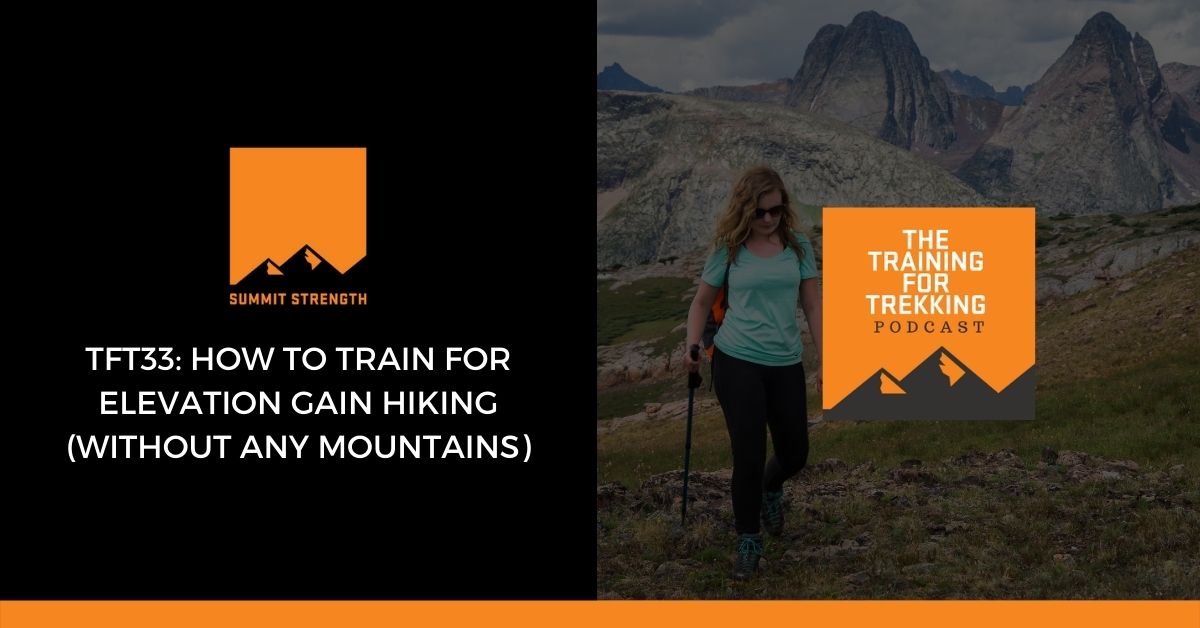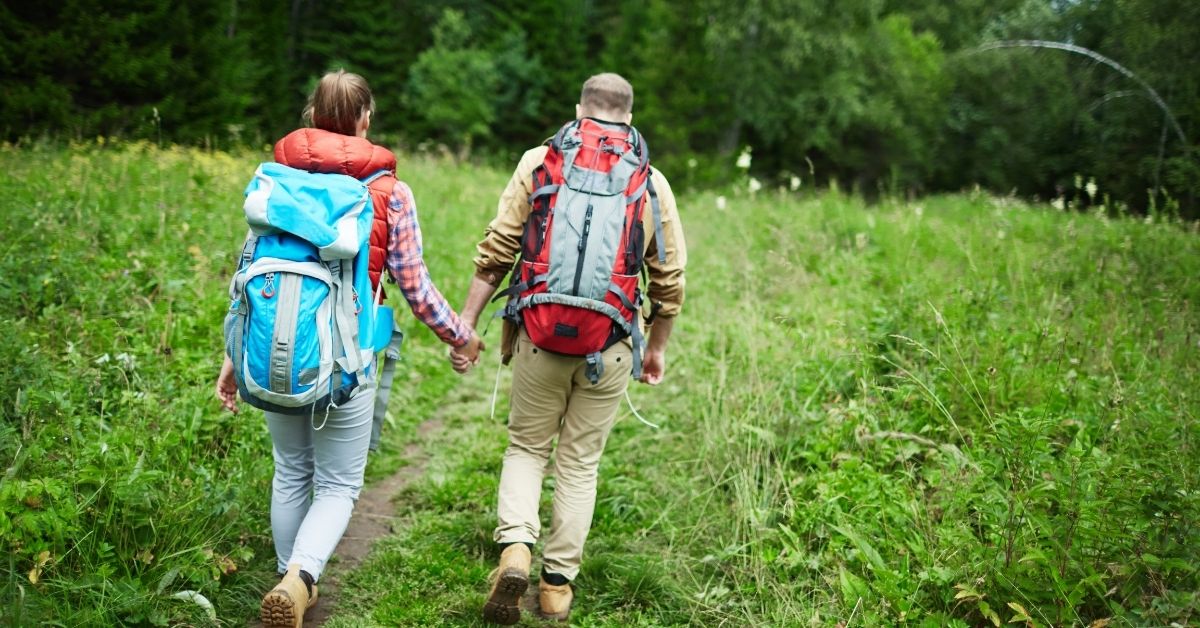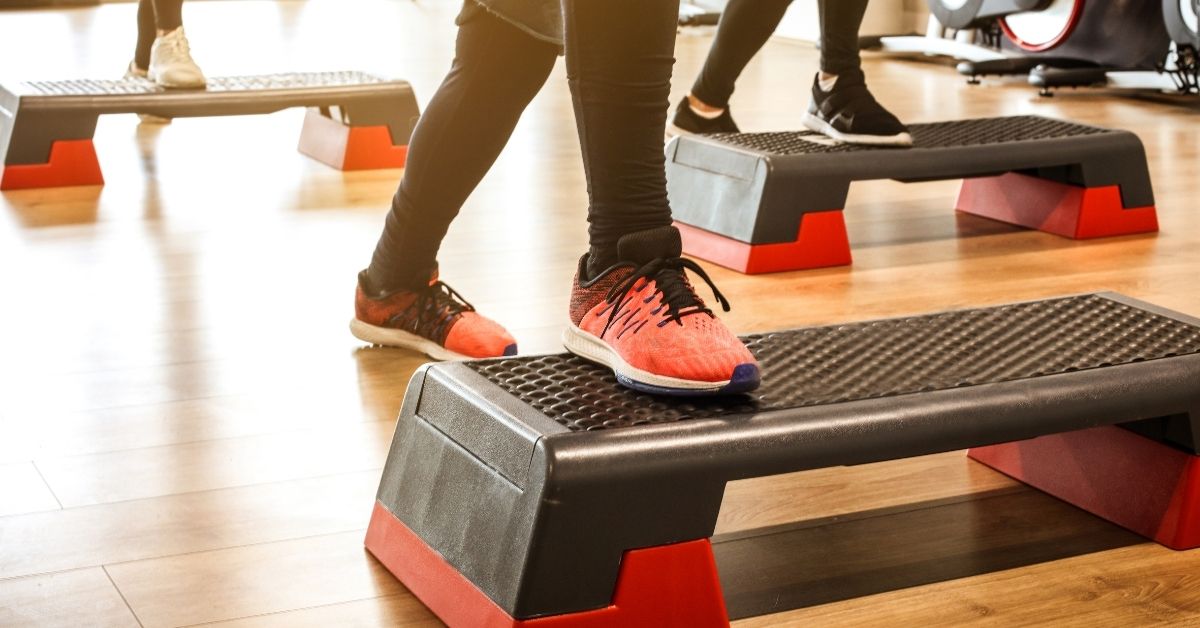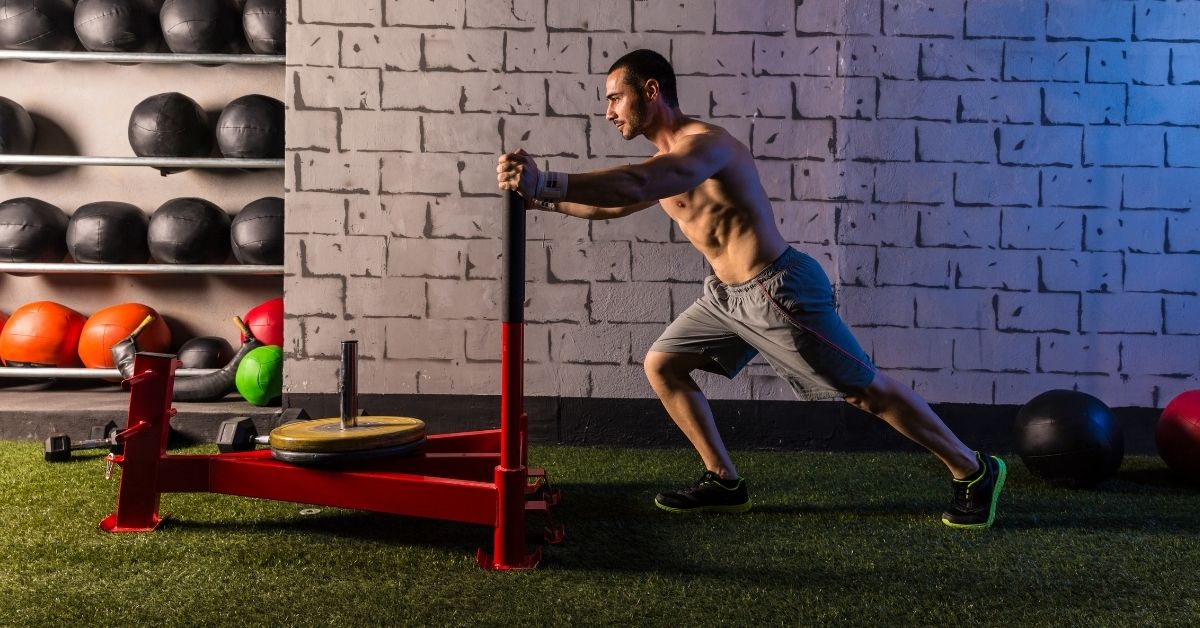|
In this episode, I discuss my simple (and proven!) formula on how to prepare your body for an elevation gain hike, if you live at sea level. One of the most common questions I hear is "Where I live is about as flat as a pancake, how can I get ready for a mountain trek?" And unfortunately, the common answers I hear usually fall a bit short... While things like "hit the stair master", "get your legs strong" and "climb some stairs" are definitely not wrong... to BEST prepare yourself for an elevation gain hike, you need to use a little more thought. So today, I share with you the simple process in which I use for my clients, which can get you fit, strong and resilient to handle any elevation your hike may throw at you (and which doesn't require a single mountain to train on!) You will learn:
PODCAST: HOW TO TRAIN FOR ELEVATION GAIN HIKING (WITHOUT ANY MOUNTAINS)
Hello, hello, guys. Today we are talking about how to train for elevation hiking if you don't have any hills. Now, this is probably one of the most common questions I get asked. And then people reach out to me, they're like, "Look, I am preparing for a big elevation hike. Whether I'm going to climb up a mountain up to somewhere like Kilimanjaro or go up to Mount Elbrus," or something like that. When they're going up a mountain alternatively, they're going on a trek where it's just lots and up and down, up and down like Kokoda.
And they're like, "Look, Rowan, I'm preparing for this trek but where I live is about as flat as a pancake. How do I get prepared to be able to walk uphill all day if I don't have any hills to walk on?" This is so, so, so common. If you are thinking this is yourself, don't worry you're not the only one. Sure, there are plenty of people in the world who are lucky enough to live near mountains and unfortunately in the hiking and the trekking world, a lot of the training information is coming from these people. Not that they have anything wrong with what they're saying, it's just, it's not incredibly practical for so many people just to climb hills to get ready for their adventures. So, what if you haven't got any mountains to Go Hiking near you?
Alternatively, I live in Sydney, which is just about one of the flattest places on earth. We have very, very, very little elevation. Very little elevation for hiking in the immediate vicinity. However, I have lots of clients coming to me to prepare for these mountain adventures or high elevation adventures and they need help.
And there definitely are things you can do and there's plenty of stuff you can be doing in your training to prepare yourself for this. And not only just prepare yourself to survive, but prepare yourself to getting a really, really solid position to perform really, really well, prevent any potential injury that might affect you and just feel really, really comfortable.
There are definitely things you can be doing and I'm going to be talking about that today. Just running you through a really simple process which I use with my clients, which I know is effective, I know that works and it is pretty simple. Even if you are not outrageously experienced in regards to training or if you're not working with a personal trainer, you can probably put this action into practice pretty, pretty straight forward. What Do I do for Hiking Training?
There's basically three main things we're going to be talking about today. And there is a running theme in a lot of my workout prescriptions because these two, three things go into any type of trek preparation program. I'm just altering the emphasis of it, it's slightly different if you've got lots of elevation. The main three things we're going to be talking about, obviously you're hiking and you're trekking, so we need to be including that is strength training and your conditioning. Plus we're going to talk about a few other particular considerations you need to be applying in order to get the best out of this preparation and get yourself in the best position.
1. Hiking, Trekking, Walking
To start off with your trek training or with your hiking. Now, obviously this is going to be a very, very essential part of your preparation. Even if you don't have any hills to hike on and you are going on what might be elevation hike, you still need to be nailing this. Mainly for the fact that you need to get your body used to be walking for hours and hours and hours at a time. You need to get your muscles, your connective tissue and everything else ready to withstand force when you go and going and going, and you need to develop your aerobic fitness so you can be comfortable for going for these periods of time. And not only that, you can have plenty of reserves so you can recover in between each day and continue going and going and going.
The hike and training just cannot be neglected and don't try to use it as an excuse that you don't have hills because it is so important. Now, always with this type of training you're looking at long-term progression. Week by week by week, you want to be increasing your distance and the difficulty of your hikes. Now, in particular for your training, for elevation hike without any hills, there are a couple of considerations you want to think about. Number one is your longest hike. You basically want to make sure that that is a longer than the maximum distance or maximum time you're going to be doing on the longest day of your adventure. For example, if you know you're going to be doing eight hour days on your adventure, you need to make sure you're reasonably comfortably walking at least or hiking at least nine or 10 hour days if it is on the flat, like that's just given. Now, sure if you're doing something like Kilimanjaro, which has some type of a ridiculous 12, 14, 16 hour summer day, you're not going to be training these distances in your normal training. It's just not practical, it's not feasible. However, from this situation you need to look at your other days of how long you are doing and you need to make sure you're comfortable going even longer than this. Really simple concept, but very, very important to do. And I usually recommend as always, when you're trek training, two weeks before your adventure try to hit your longest distance in your training so you basically schedule that longest distance in, and then work your way backwards with a calendar and figure out what other distances you're doing. Really, really simple. Number two is you want to be making sure you're training or eventually get into your hiking training arm with a loaded pack, which is slightly heavier than what you'd be carrying on the mountain on your trek. Now the idea behind this is yes, there's no hills or very little hills in your regular trek training which can prepare you for the elevation, but if you can put a little extra load on the body while you're doing your normal hiking, this is going to be relatively effective here. Now you don't want to go outrageous here, you don't want to absolutely stack up your pack and put yourself at a much higher risk of things like overuse injuries, but you want to do a sort of gradual progression here as well.
If in the first four weeks you were hiking with something like a six kilo pack, maybe the next four weeks you might be hiking with a nine kilo pack and slowly progress. A really, really good way of judging this is you never want to increase the weight of your pack by more than 10% each week, and you also need to consider not doing jumps in both your pack weight and your distance at the same week.
Quite often what I recommend for people is alternate week by week. And they might do let's say, a 10 kilometer hike one week with a seven kilo pack, next week a 12 kilometer hike with a seven kilo pack. Next week, a 12 kilometer hike again, but maybe with a nine or 10 kilo pack. There's a million ways you can progress this, but the main key here is just to not do two massive jumps in weight or distance at the same time. Now, eventually by the end of those last two weeks, again, you want to be pretty happy that you can confidently carry a heavier pack than you're expecting on the mountain for long periods of time. And this can be really, really, really beneficial to help you get ready for this elevation. There are the two main points that are a little bit different than the normal trek training, and I highly recommend you put that into action if you are preparing for elevation and you don't have any hills to train on. And moving forward into the next section is strength training. 2. Strength Training for hiking
Now strength training is probably almost the best thing you can be doing to prepare your body for the rigors of elevation if you're not lucky enough to be training on hills. And basically you can overload the body, overload the muscles, overload the connective tissue and get it used to absorbing and producing big amounts of force in which it'll very, very much transfer onto your time on the mountain.
Now, this is really, really important for both two situations. Obviously, going up, going up and up and up and up, step by step, step by step for hours and hours is really, really tough, so the stronger you can get here, the better. Also going downhill, we all know downhills are super, super strenuous, super, super tough. The stronger you can get here, the more resilient you can give your tissues, the more beneficial this is going to be. Now again, there are a million ways you can go about your strength training, but this is, I'm going to describe a really, really simple structure which more or less anyone can put into action. Basically your strength training is going to be divided into three separate phases. And these phases will go anywhere from four to eight weeks depending on how long you have to train. Now, your first phase is basically called a preparatory phase. Now this phase is just about getting the body used to doing some type of strength training, getting some initial gains in strength, learning the movements or the movement patterns that are very, very commonly used in strength training. Things like learning how to squat, learning how to lunge, learning how to deadlift and hinge. You might already know how to do these things, but spending a bit of time at the start of every program is really, really, really important just to get the body moving properly and getting used to it.
The first phase is super simple. Choose a range of exercises which are going to go through those movements. Do maybe three or four sets of each exercise, maybe 10 to 12 repetitions. A little bit heavier if you're used to strength training, 10 to 12 if you're new to it. Super, super easy, super, super simple. You can walk into any gym in the world and more or less be able to get a program written out like that. It's not too much dramas.
Now the next phase we're going to be going into is the strength phase. And this is where you want to add a little bit extra load to the muscles and develop something that's called your strength reserve. Now your strength reserve is incredibly relevant to elevation hiking. Basically, it's the difference between your maximal strength and the strength needed for a given task. Now, this comes into really, really relevance when you're taking steps up a hill. Now, if you're... let's use an example for if you are stepping up a hill and every single step that you took, took to say 30% of your maximal strength to do that step and then you had 30% again to do the next step and so on and so on. Now, that is going to fatigue very, very, very quickly. Alternatively, if you spend a bit of time strength training and you went back and did the same hill and every single step you took, took say 15% of your maximal strength, you're going to get tired a lot less quickly and that's basically what we're looking at with developing strength reserve. We're just trying to get develop some maximal strength and the ability of our muscles to produce a lot more force and that's just going to make every single step we take quite a bit easier. Now the way you develop this is just in simply adding a little extra load to whatever strength exercises you've been doing. Now this is, if you are an experienced lifter, you might be doing repetitions of somewhere from three to six repetitions. For someone who's a little bit newer to strength training might be doing something from six to eight repetitions. Now you don't have to get bogged down by the numbers too much, but basically this stage you're just trying to do not so many repetitions and just increase the weight a little bit. And you want to be giving yourself a reasonable amount of strain here. Don't have to go to failure, don't have to really, really, absolutely push yourself to the limit, but here you want to challenge yourself a little bit. Now I'll say of all the phases in your strength training, if you are really trying to be on budget and you're not 100% sure about this and you can't afford a trainer or help throughout the entire process, I highly recommend you at least hire a trainer for this process. A little bit of supervision if you don't know what you're doing goes a huge, huge way here and I highly recommend it.
Now, one exercise that I won't get too much into specifics here, but one exercise I want 100% recommend including in this stage is something called a low box step up, which is 100% specific for the trail. Basically involves you finding a little step or box, which is about mid in height or less, it does not have to be tall. And you're either going to grab yourself a couple of dumbbells and do step ups on there, or if you're relatively experienced and you're happy with a barbell on your back doing barbell on your back and then step ups on there. And you're doing low repetitions or something like five, six repetitions with quite a reasonable amount of weight and you do want maybe three, four or five sets of this.
Now this exercise in itself is absolutely amazing because it exactly mimics what you're doing on the trail and it's also incredibly easy to learn. Even if you're super new to exercise, if you get a little bit of instruction from a professional on this and teach you how to do the key points, you can pick it up really, really quickly and a highly recommend you put that in. Now once you've done your strength development or your strength phase and you're going to move on to the final phase of your preparation, which is the muscular endurance phase. Now, this is what 99% of trekkers and hikers already know. This high repetition, low weight exercise where you're just basically chasing your muscular burn. It's really, really simple to put together. You just choose a bunch of leg exercises and just do lots and lots of repetitions of them working at a pace where your legs are burning but you're not getting so huffed and puffed. And you just do maybe work in a circuit or lots of sets and you do this for four to six weeks and this is a really, really good way to take all that strength reserve you developed and really, really push that into this incredibly specific muscular endurance which is so beneficial on the trail. That's super straight forward, I'm not going to go into that too much more detail. I will say you only really need six weeks maximum of this, so if you do have more than six weeks to prepare, please do make sure you go through those other phases because it's really not worth doing for longer than that. That's your strength training. Now, the reason why I went over that process in relative detail is because it's so, so important. And if you string together that very, very simple structure, you will go a long, long way. If you've never trained like that before and you do that for 12 weeks, you will be a new hiker, I guarantee you. And you will feel $1 million walking up hills and you'll be," Hey, why haven't I done this before? Why have I waited so long?" Because the change is just phenomenal. 3. Conditioning
All right. And then number three after your strength training, we want to be talking about conditioning. Now, obviously when we're hiking and we're trekking and doing our trek training, we are doing some type of conditioning because we're doing aerobic conditioning to get ourselves more fit to walk on the trail. Now, I always like to include additional conditioning through the week for my trekkers, maybe not so long, which takes such big time commitments of being on the trail for hours and hours and hours. But something a little bit shorter through the week that you can number one, you can make sure you're increasing that aerobic conditioning throughout the week. And number two that you can use this opportunity to work on very, very specific things that are going to help you on the trail.
Now in particular for people who are training for elevation and they don't have any hills, there are two types of workouts in this I would recommend which you would choose one or the other and do it in your week. Now, number one is something that's called aerobic power intervals, which I mentioned quite a few times on this podcast. Without getting too complicated, it's basically intervals of around about three minutes where you go relatively quickly and go quick, quick, quick, quick, quick. By the end you are relatively huffed and puffed and then you have about 90 seconds to two minutes rest of just walking around or just chilling out, catching a breath, and then you go again and you repeat that again and again and again. Now the idea behind this is to work at the maximum rate of your aerobic energy system and teach the body to be able to work at higher intensities while using oxygen as a fuel source. Now this is outrageously relevant for going up elevation, purely for the fact that if you're going uphills, uphills, uphills, you still want to be working in your aerobic energy system or you're going to burn out really quickly. If you're working in your other energy systems like your anaerobic ones where you're huffing and puffing your way up the hills, you just churn through energy, it's not good, it's not efficient and that's not what you want. Being able to develop the body to work at a higher intensity in this aerobic zone, it's really, really effective. Now the way you structure this out is initially for this and for the next workout I'm going to mention, and then this will stage as your preparation, you don't need to worry about doing too specific for the trail. You can choose any type of cardiovascular exercise which will be pretty beneficial. You can do things like being on the row up, being on a bike, whether it's indoor, outdoor. Being on a cross trainer in the gym, being in the pool and swimming, doing running if you're already a runner. That doesn't really matter what you do in the initial stages. As you get a bit closer to your treks and maybe eight weeks out or something, you might get a bit more specific. You might be doing these intervals on things like sets of stairs in an apartment tower. Even if you have no hills around, everyone can find a set of stairs in the fire escape of an apartment tower or an office tower and there really are no excuses there. Or if you do happen to be able to find a hill, which is about three minutes, take about three minutes to climb and you can hustle up that, good on you there. The other alternative as well, in a gym, if you are looking for very, very specific stuff, there's two options or three options, sorry. You can either choose a maximum incline treadmill walk and put a load of pack on that and you can do that for three minutes and get your pretty huffed and puffed.
You can do sled pushing for three minutes, load on a reasonable amount of weight and just push, push, push for three minutes. Or you can use the StairMaster for three minutes and try to push that. Now, the key on this workout is just to get huffed and puffed by the end of the three minutes. Take your time recovering and just repeat that.
Now, the other type of conditioning that I recommend for hikers and trekkers preparing for elevation is longer intervals. These are things that are ranged anywhere from six minutes all the way up to 30 minute intervals. And the idea behind this is just to teach the body to be able to just go and go and go and go. Now these ones aren't so much about getting you huffed and puffed, it's more about chasing that muscle burn and it's about developing that muscular endurance that I was talking about in your strength sessions. Here initially, it doesn't really matter what you choose. Again, you can choose any type of cardiovascular exercise that as you get closer to your trek you want to be doing this stuff on more specific things. Stairs, stair climb, sled, high inclined treadmill, and you basically want to start at something like six minutes at a time and then each week you do it just increase the distance on your intervals and keep the rest the same. If the first week you might do six minutes or on and 90 seconds rest, next week you might do eight minutes on 90 seconds rest, and then slowly, slowly, slowly increase up. Now before I was heading off on my trip to Kokoda, we were doing started initially eight minutes on, two minutes off on a stair climber and we went to 10 minutes, two minutes, 12 minutes, two minutes. Then we took a big jump up to 15 minutes and then we ended up doing 30 minutes at a time just go, go, go, go. And that's relatively effective and anyone can more or less access one of those things. Now, they're the three big things that I highly, highly, highly recommend you including a programming. That is a structured strength training program, a structured trek training program and those two types, specific types and conditioning exercises. Obviously if you don't know how to apply all that, please reach out for help because the application of that does take a little bit of thought and it does go a long, long, long way. Accessory workouts for Hiking
Now on top of all of that, there are a few other bits and pieces that I would recommend you practice in your training in getting your head.
Now, number one, I highly recommend you train abdominal breathing. Abdominal breathing is a really, really great way of just keeping the body calm, relaxed, and be able to utilize oxygen very, very effectively while you're trekking. It basically involves you breathing in through the nose and a pause to just feeling the chest in the shoulders rise up, trying to feel the belly expand. Now practicing this at home in your training, while you're out hiking's really, really effective. And then basically when you're going uphill all day, you can keep on bringing yourself back to remembering about that breathing and really, really keep everything under control and it's a very, very effective tool. Number two, I'm highly recommend if you do have any type of mobility restrictions that you're aware of or if you've been identified by a professional to make sure you use this time to work on it specifically, I highly recommend if you have tight ankles that's going to suck going uphill, it really gets in the way of you stepping correctly. Really puts an extra pressure in your feet, in your knees and I really recommend if you do know you have tight ankles, spend some dedicated time mobilizing these. The same goes for your hips. If your hips are just super, super tight, your knees and your back are going to take a reasonable amount of effort and a reasonable amount of force and it's just going to make everything quite a bit harder. Now, on top of that I would highly recommend including some type of core training as well. Obviously your core and your dominoes connect everything in the body. If you are going uphill or downhill all day, you want as much stability as you can and you want as much power transfer through the body. Which basically means if your limbs are connected from the top to the bottom, you can transfer the power through it effectively and you're not losing any energy when you're putting force into the ground with every single step. Now, core training is really, really complicated. No, it's not really, really complicated, it's really, really butchered, I should say. Basically, core training is not sit ups and crunches. Those things really are little, little, little relevance. Three things I always recommend trekkers do, dead bugs, side planks and something called Pallof press, P-A-L-L-O-F press. If you don't know what those are, plug into Google, start doing them because they're so, so, so effective.
Now, I don't expect you to be spending a day to day designated time doing core, designated sessions doing mobility, but I'd usually recommend taking those two things and include them in your strength training program and you can be relatively time efficient there.
Wrapping Up
Covered a whole bunch there today. Put this information into action and you will not only get your body fit, strong, and resilient to get through this elevation even if you don't have any hills, but I would not be surprised if you are in a much better position to conquer this adventure than many, many, many other people who might have the luxury on training on mountains. This stuff works. It's worked for many of my clients and I'm 100% sure that it'll work for you if you apply it correctly. If you need help, reach out to a professional, reach out to me. There's always someone there to support you, that it will work and you just have to go out and make it happen.
I hope you've enjoyed the episode today guys. I hope you've got a little bit out of this. As always, if you have any questions, please do reach out to me and if you have enjoyed it, as always please, I would really, really love if you can leave me a five star review on iTunes. It goes a long, long, long way to helping develop and grow and reach more people in this podcast. Again, thank you for listening and we'll talk to you very, very soon. Want More
|
AuthorRowan is a personal trainer who specialises in training for hiking, trekkers and mountaineers for their bucket list adventures. Archives
July 2024
Categories
All
|
AboutSummit Strength is a personal training for hiking service created specifically to help hikers have the best chance of a safe, enjoyable and successful adventure.
|
Company |
Services |
|
|
© COPYRIGHT 2018. ALL RIGHTS RESERVED.
|
Website Design by My Personal Trainer Website
|







 RSS Feed
RSS Feed
